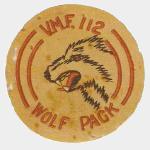Corgi US33014 USMC Chance-Vought F4U-1C Corsair Fighter - VMF-112 "Wolf Pack", Air Group 82, USS Bennington (CV-20), April 1945 (1:72 Scale)
"Why should we have a navy at all? There are no enemies for it to fight except apparently the Army Air Force."
- General Carl Spaatz, Commander of the US 8th Army Air Force, after WWII
 Its gull-wing shape made it instantly recognizable. Its characteristic sound while in an attack dive led the Japanese to call it "The Whistling Death." Combined with its high speed, agility and toughness, the Vought F4U Corsair was one of the finest fighters ever built. Originally thought to be too powerful to fly from a carrier, the Corsair weaved a path of destruction in battle after battle during WWII, totally outclassing the much-feared Zero. The last of the great piston-engine fighters, the Corsair went on to become an important component of the US naval air power during the Korean War. Even while it was being replaced by jet aircraft, pilots flying this tough warbird were credited with downing a few MiG-15 jet fighters.
Its gull-wing shape made it instantly recognizable. Its characteristic sound while in an attack dive led the Japanese to call it "The Whistling Death." Combined with its high speed, agility and toughness, the Vought F4U Corsair was one of the finest fighters ever built. Originally thought to be too powerful to fly from a carrier, the Corsair weaved a path of destruction in battle after battle during WWII, totally outclassing the much-feared Zero. The last of the great piston-engine fighters, the Corsair went on to become an important component of the US naval air power during the Korean War. Even while it was being replaced by jet aircraft, pilots flying this tough warbird were credited with downing a few MiG-15 jet fighters.
Pictured here is a 1:72 scale replica of a USMC Chance-Vought F4U-1C Corsair fighter that was attached to VMF-112 "Wolf Pack", Air Group 82, then embarked upon the USS Bennington, during April 1945.
Sold Out!
Dimensions:
Wingspan: 6-3/4-inches
Length: 5-1/2-inches
Release Date: August 2009
 Historical Account: "Wolfpack" - Marine Fighter Attack Squadron 112, was originally activated as VMF-112, at San Diego, California on March 1st, 1942.
Historical Account: "Wolfpack" - Marine Fighter Attack Squadron 112, was originally activated as VMF-112, at San Diego, California on March 1st, 1942.
Deploying shortly after to Henderson Field on Guadalcanal in the Solomon Islands in their F4F Wildcats, the Wolfpack joined the Cactus Air Force with Marine Aircraft Group 11. In recognition of its valor and its contributions to victory during its service on Guadalcanal, VMF-112 was awarded the Presidential Unit Citation (US) for August 7th - December 9th, 1942.
VMF-112 was withdrawn from Guadalcanal to Espiritu Santo for a respite. There it began to switch to the Vought F4U-1 Corsair, the aircraft that it would fly for the rest of World War II. VMF-112 returned to the United States on September 5th, 1943, and took up duty at MCAS Miramar, outside of San Diego. It was there that VMF-112 was redesignated VMF(CVS)-112, denoting that the squadron was carrier qualified. In December 1944, VMF-112 was assigned to Air Group 82 aboard USS Bennington for its second combat tour. In mid-May 1945, Lieutenant Robert Cook scored the only downing of a barrage balloon by a Marine squadron during the war when he shot one down over Kyushu. By the completion of World War II, the Wolfpack was credited with the destruction of 140 Japanese aircraft in aerial combat, ranking it third among Marine Corps squadrons in terms of enemy aircraft destroyed. Following the surrender of Japan VMF-112 returned to the United States where it was deactivated on September 10th, 1945.





![US 1-3/4-Ton GPA Amphibian Jeep - 3rd Armored Division, Normandy, 1944 [D-Day Commemorative Packaging] (1:32 Scale)](http://cdn4.volusion.store/qh9e9-jdqv9/v/vspfiles/photos/UNI82010-1.jpg?v-cache=1740197136)



